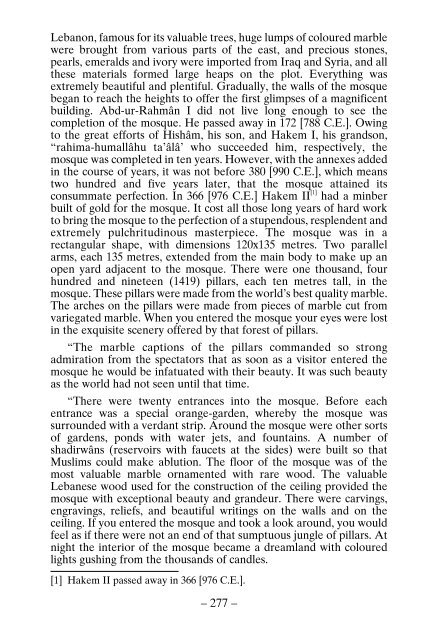Why Did They Become Muslims
WHY DID THEY BECOME MUSLIMS? The book Why Did They Become Muslims consists of 3 sections. Section I is a book of Islam and Christianity. Information about Prophets, books, religions (Judaism, Christianity and Islam) is given, conditions of being a true Muslim are explained, the words of those filled with admiration for Islam and the lives of 42 people who being a member of other religions chose Islam are narrated. Section II is a book of the Qur’an-ı Karîm and the Torah and the Bibles as of Today. Information about today’s Torah and Bibles is given, errors in the Bible are explained; that the Qur’an-ı Karîm is the last and unchangeable book is explained scientifically. Besides, explained are miracles, virtues, moral practices and habits of Muhammad ´alayhissalâm. Section III is a book of Islam and Other Religions. That Islam is not a religion of savageness, that a true Muslim is not ignorant, that there can be no philosophy in Islam are explained along with explanations of primitive religions and celestial religions.
WHY DID THEY BECOME MUSLIMS?
The book Why Did They Become Muslims consists of 3 sections. Section I is a book of Islam and Christianity. Information about Prophets, books, religions (Judaism, Christianity and Islam) is given, conditions of being a true Muslim are explained, the words of those filled with admiration for Islam and the lives of 42 people who being a member of other religions chose Islam are narrated. Section II is a book of the Qur’an-ı Karîm and the Torah and the Bibles as of Today. Information about today’s Torah and Bibles is given, errors in the Bible are explained; that the Qur’an-ı Karîm is the last and unchangeable book is explained scientifically. Besides, explained are miracles, virtues, moral practices and habits of Muhammad ´alayhissalâm. Section III is a book of Islam and Other Religions. That Islam is not a religion of savageness, that a true Muslim is not ignorant, that there can be no philosophy in Islam are explained along with explanations of primitive religions and celestial religions.
You also want an ePaper? Increase the reach of your titles
YUMPU automatically turns print PDFs into web optimized ePapers that Google loves.
Lebanon, famous for its valuable trees, huge lumps of coloured marble<br />
were brought from various parts of the east, and precious stones,<br />
pearls, emeralds and ivory were imported from Iraq and Syria, and all<br />
these materials formed large heaps on the plot. Everything was<br />
extremely beautiful and plentiful. Gradually, the walls of the mosque<br />
began to reach the heights to offer the first glimpses of a magnificent<br />
building. Abd-ur-Rahmân I did not live long enough to see the<br />
completion of the mosque. He passed away in 172 [788 C.E.]. Owing<br />
to the great efforts of Hishâm, his son, and Hakem I, his grandson,<br />
“rahima-humallâhu ta’âlâ’ who succeeded him, respectively, the<br />
mosque was completed in ten years. However, with the annexes added<br />
in the course of years, it was not before 380 [990 C.E.], which means<br />
two hundred and five years later, that the mosque attained its<br />
consummate perfection. In 366 [976 C.E.] Hakem II [1] had a minber<br />
built of gold for the mosque. It cost all those long years of hard work<br />
to bring the mosque to the perfection of a stupendous, resplendent and<br />
extremely pulchritudinous masterpiece. The mosque was in a<br />
rectangular shape, with dimensions 120x135 metres. Two parallel<br />
arms, each 135 metres, extended from the main body to make up an<br />
open yard adjacent to the mosque. There were one thousand, four<br />
hundred and nineteen (1419) pillars, each ten metres tall, in the<br />
mosque. These pillars were made from the world’s best quality marble.<br />
The arches on the pillars were made from pieces of marble cut from<br />
variegated marble. When you entered the mosque your eyes were lost<br />
in the exquisite scenery offered by that forest of pillars.<br />
“The marble captions of the pillars commanded so strong<br />
admiration from the spectators that as soon as a visitor entered the<br />
mosque he would be infatuated with their beauty. It was such beauty<br />
as the world had not seen until that time.<br />
“There were twenty entrances into the mosque. Before each<br />
entrance was a special orange-garden, whereby the mosque was<br />
surrounded with a verdant strip. Around the mosque were other sorts<br />
of gardens, ponds with water jets, and fountains. A number of<br />
shadirwâns (reservoirs with faucets at the sides) were built so that<br />
<strong>Muslims</strong> could make ablution. The floor of the mosque was of the<br />
most valuable marble ornamented with rare wood. The valuable<br />
Lebanese wood used for the construction of the ceiling provided the<br />
mosque with exceptional beauty and grandeur. There were carvings,<br />
engravings, reliefs, and beautiful writings on the walls and on the<br />
ceiling. If you entered the mosque and took a look around, you would<br />
feel as if there were not an end of that sumptuous jungle of pillars. At<br />
night the interior of the mosque became a dreamland with coloured<br />
lights gushing from the thousands of candles.<br />
[1] Hakem II passed away in 366 [976 C.E.].<br />
– 277 –

















